The La Nina is getting colder than expected in the equatorial Pacific, making its influence on the Winter season more certain. The latest forecast calls for the La Nina to continue into early Spring 2022, with an increasing chance for an El Nino emerging for next Winter 2022/2023, creating a completely different picture.
But what exactly is this La Nina, and how can it be so powerful to impact the seasonal winter weather across the entire Northern Hemisphere? As we will quickly find out, La Nina is actually a part of a large system that connects the ocean and the atmosphere called the ENSO.
We will also look at the current conditions across the ENSO region, the latest forecast, how it impacts winter, and how strong is the La Nina signal in the latest forecast for the Winter season 2021/2022.
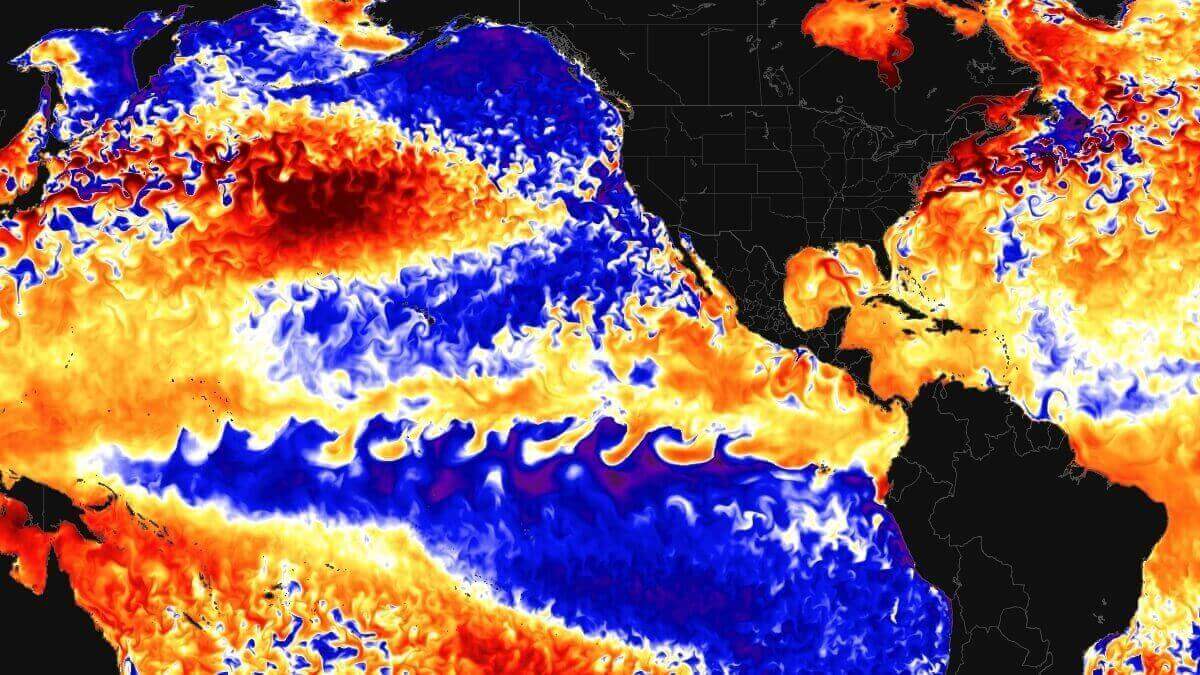
EL NINO SOUTHERN OSCILLATION
To keep it as simple as possible, ENSO is short for “El Niño Southern Oscillation”. This is a region of ocean in the tropical Pacific, which is always changing between warm and cold phases, called El Nino and La Nina, respectfully.
ENSO has a major impact on the tropical convection patterns and the complex interaction of the ocean-atmosphere system. We can observe large-scale pressure patterns in the tropics with each developing phase. With some delay, these changes affect the circulation over the rest of the world.
The image below shows the ENSO regions in the tropical Pacific. The main regions are 3 and 4 and together cover a large part of the tropical Pacific. Most analyses and forecasts are based on a combination of regions 3 and 4, seen on the image as the Nino 3.4 region. Region 3 covers the eastern tropical Pacific, while region 4 covers the central and western parts.

Each ENSO phase has a different effect on the weather in the tropics and the overall circulation and thus impacting the weather worldwide differently. A specific phase (cold/warm) usually develops in late summer and autumn and can last until next summer, or even up to two years in some cases.
The cold ENSO phase is called La Nina and the warm phase is called El Nino. The name La Nina literally translates to “the girl”, and the name El Nino translates to “the boy”, indicating an opposite relation between the phases.
We determine the ENSO phase by the sea surface temperature anomalies (warmer/colder) in the ENSO 3.4 region in the tropical Pacific, which you saw in the image above.
The image below from NOAA Climate shows the typical circulation during a cold ENSO phase that we are currently in. Air descends in the eastern Pacific, causing stable and dry weather, while air rises in the western Pacific, causing frequent thunderstorms and a lot of rainfall.
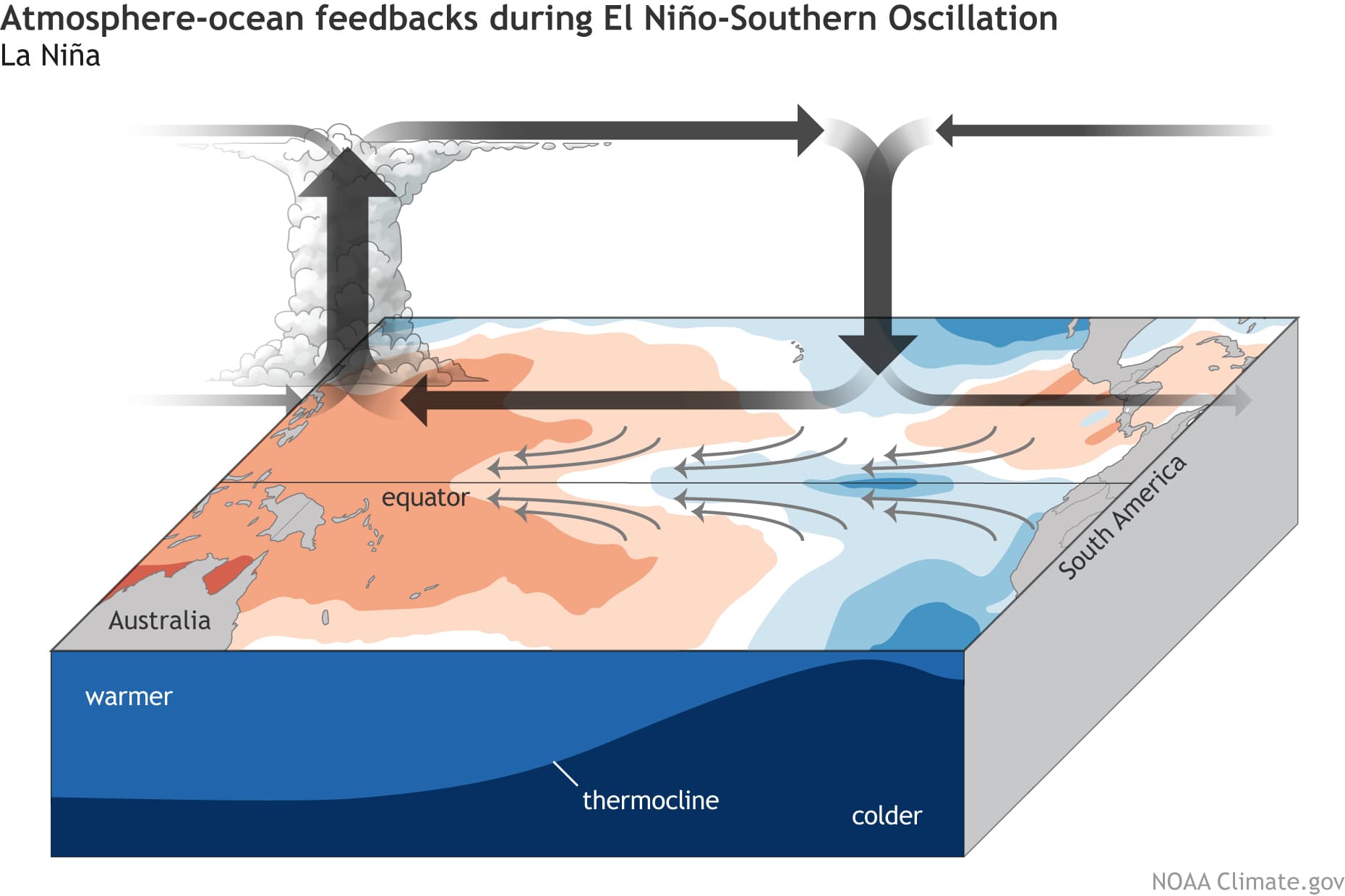
This way, ENSO has a major impact on the tropical rainfall and pressure patterns and impacts the ocean-atmosphere feedback system. Through this ocean-atmosphere system, the ENSO influence is distributed globally. We usually observe a global shift in pressure patterns during the emergence and duration of the ENSO phases.
But what causes these cold and warm ENSO phases? There is no simple answer, but we can say that it is a result of the complex dynamics between pressure patterns and winds. The tropical trade winds usually initiate or stop a certain phase, as they mix the ocean surface and alter the ocean currents and change the temperature.
To keep it simple, the trade winds are steady, and persistent winds, which blow towards (and along) the Equator in both Hemispheres. The image below from Weather.gov nicely shows a simplified version of the global prevailing winds. Trade winds are in yellow and red, depending on the Hemisphere.

When these easterly winds get stronger, they can actually start changing the ocean surface currents, and they can start pushing the water from east to west. This moves warm surface waters towards the west, bringing deeper (colder) waters towards the surface.
This process is much better seen on the video animation below, which shows the ocean temperature anomalies from Spring to Fall. You can see new cooling starting in July. Notice the “waveforms” across the region, as the surface water is being pushed west by the trade winds, bringing cooler water to the surface.
The image below shows the latest ocean surface currents in the ENSO regions. We can see strong easterly currents, which are pushing the water towards the west, and cooling the ocean surface. The easterly regions are usually always colder than the western.
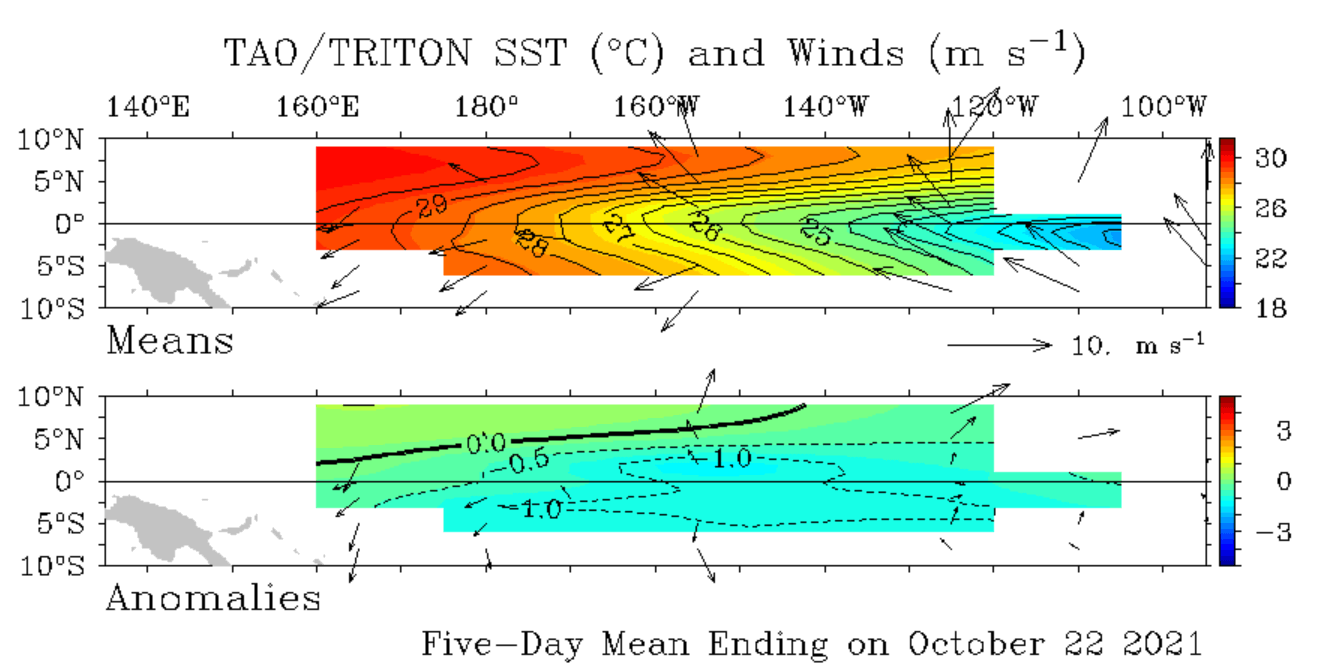
But the secret is not just in the winds themselves, as they are being driven by pressure changes. The ENSO phase directly responds to a unique atmospheric pressure variability, called the Southern Oscillation Index.
The Southern Oscillation Index or SOI represents the difference in average air pressure measured at Tahiti (French Polynesia) and Darwin (Australia). The image below shows the location of the two pressure zones.

Positive SOI values indicate that the pressure over the Tahiti side is higher than over Darwin in Australia. This corresponds to La Nina conditions. But during an El Nino, we see lower pressure in the eastern Pacific and over Tahiti, and higher over Darwin, Australia. This produces a negative SOI value.
The SOI tells us what the pressure pattern looks like in the tropical Pacific, which then affects the trade winds, warming or cooling the ENSO regions.
We have the 30-day average SOI values on the image below, which show the positive values and confirm the presence and further development of the La Nina. The SOI can be used to determine the potential effect or direct influence of the ENSO phase on the climate in the western Pacific and Australia.
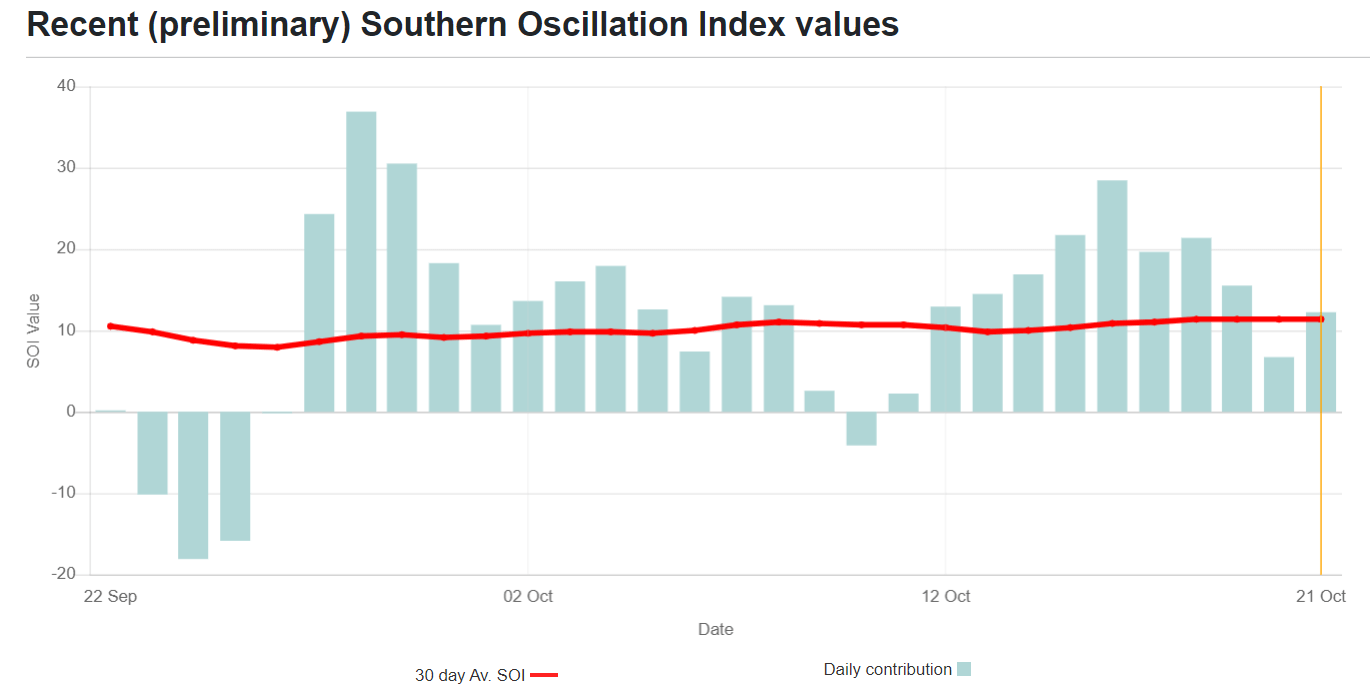
LA NINA – CURRENT CONDITIONS
Current global ocean anomaly analysis reveals a very well-seen cooling in the tropical Pacific. This is exactly in the ENSO 3.4 region, seen earlier above. The “wave-like” shape of the cold anomalies indicates strong trade winds, pushing the surface waters from east to west.

Some of the cold anomalies are actually leftover from the strong La Nina that lasted from last Autumn and over Winter, ending this Spring. The image below shows the temperature progression in the ENSO regions, where you can see the La Nina phase in 2020/2021, ending this Spring. New (current) cooling began during the Summer.

An interesting fact in the image above is that a lot of first-year La Ninas continue to evolve into a second La Nina next cold season. This is exactly what we are seeing this year, with new cooling emerging in the ENSO region. Such an event is called a second-year La Nina.
But it is not unusual to have two La Nina events follow each other. In fact, of the twelve first-year La Nina events, eight were followed by La Nina the next winter, two by neutral, and two by El Nino.
The current cooling has been quite substantial and persistent over the past weeks. The image below shows the sea surface temperatures in the main ENSO 3.4 region. We can see a steady temperature drop since early July, which is expected to continue, with some intermittent warming in-between.
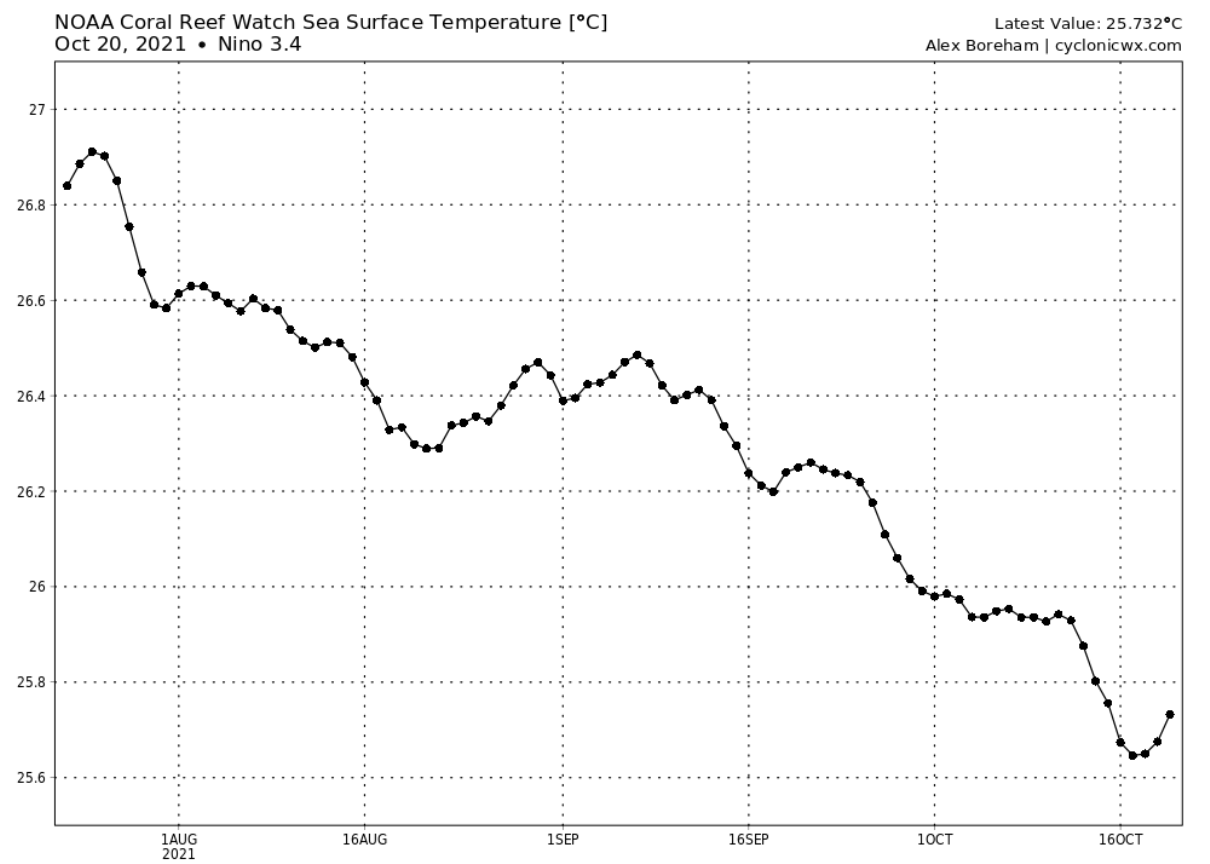
But we have to remove the normal temperatures, to see the actual cooling, and the cold anomalies. The image below shows the temperature anomaly in the ENSO 3.4 region and reveals a stronger deviation from the norm since mid-September, due to stronger trade winds.
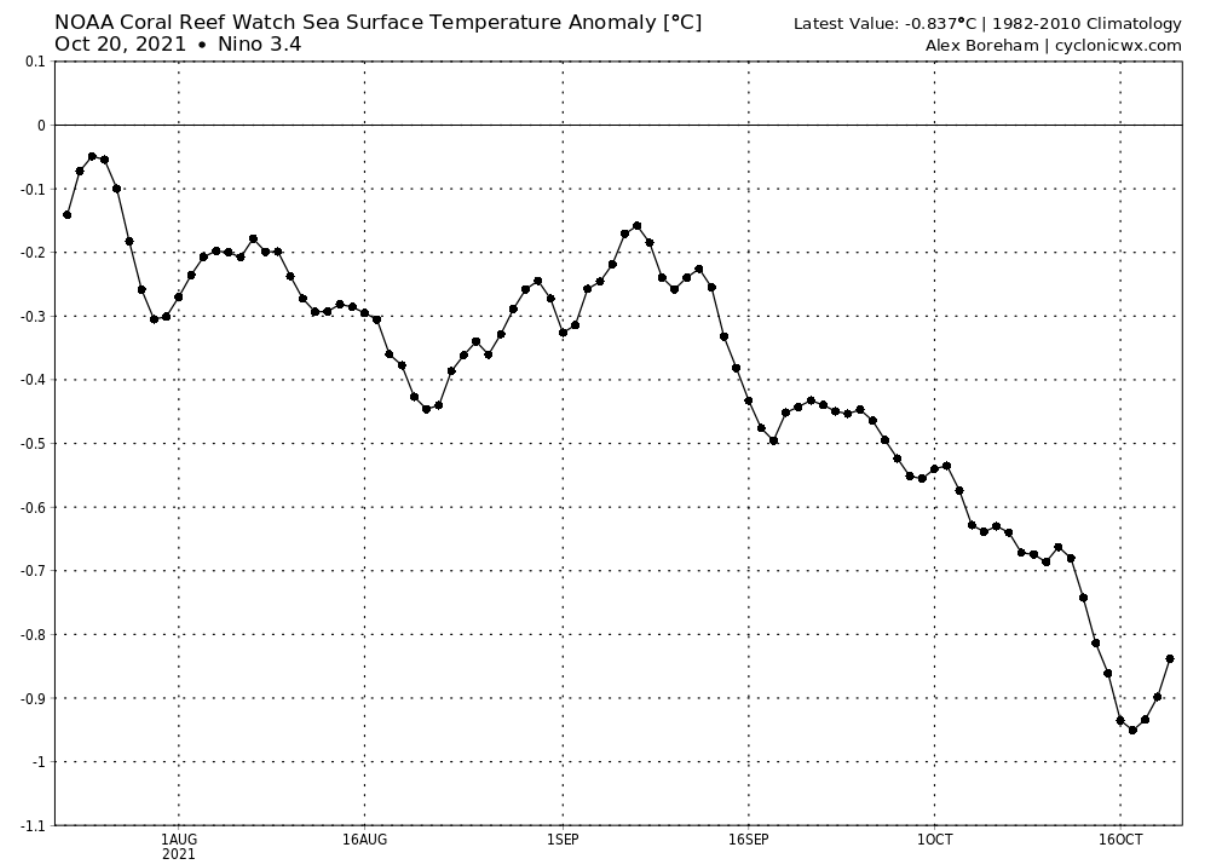
Below we have a close-up image of the ENSO regions. You can nicely see the developing cold “waveforms”, as the pressure patterns are creating strong trade winds, forcing the wind-driven ocean cooling.

Looking back a month ago, we can see the La Nina was not as strong, as it was just in the early stages. The cold waveforms were also not as defined, as the easterly winds were not as strong, and powered up in the next days/weeks.
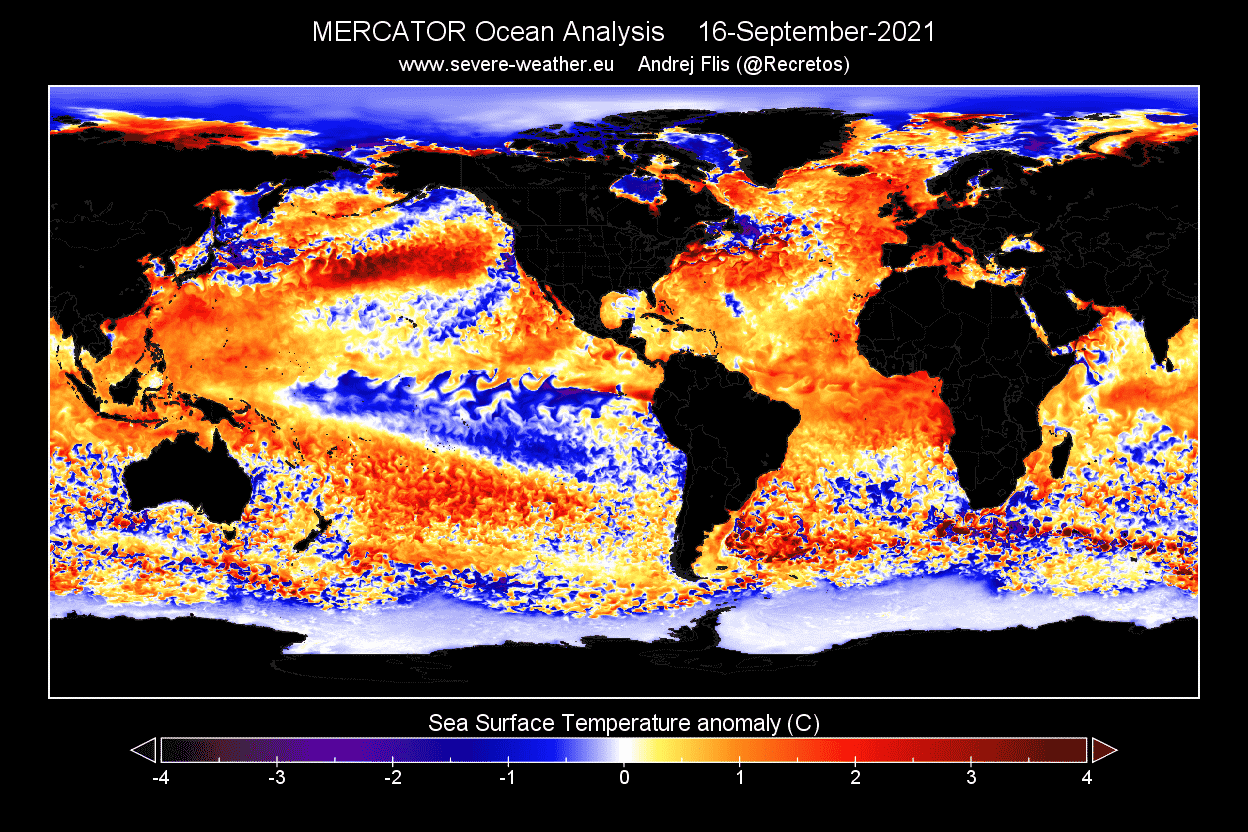
If we look at the actual current temperatures, they reveal a “cold-tongue” extending from South America, towards the west, directly across the equator. In this region, the surface waters are always colder than the surrounding regions, but during a La Nina event, they can be up to 4°C colder than normal.
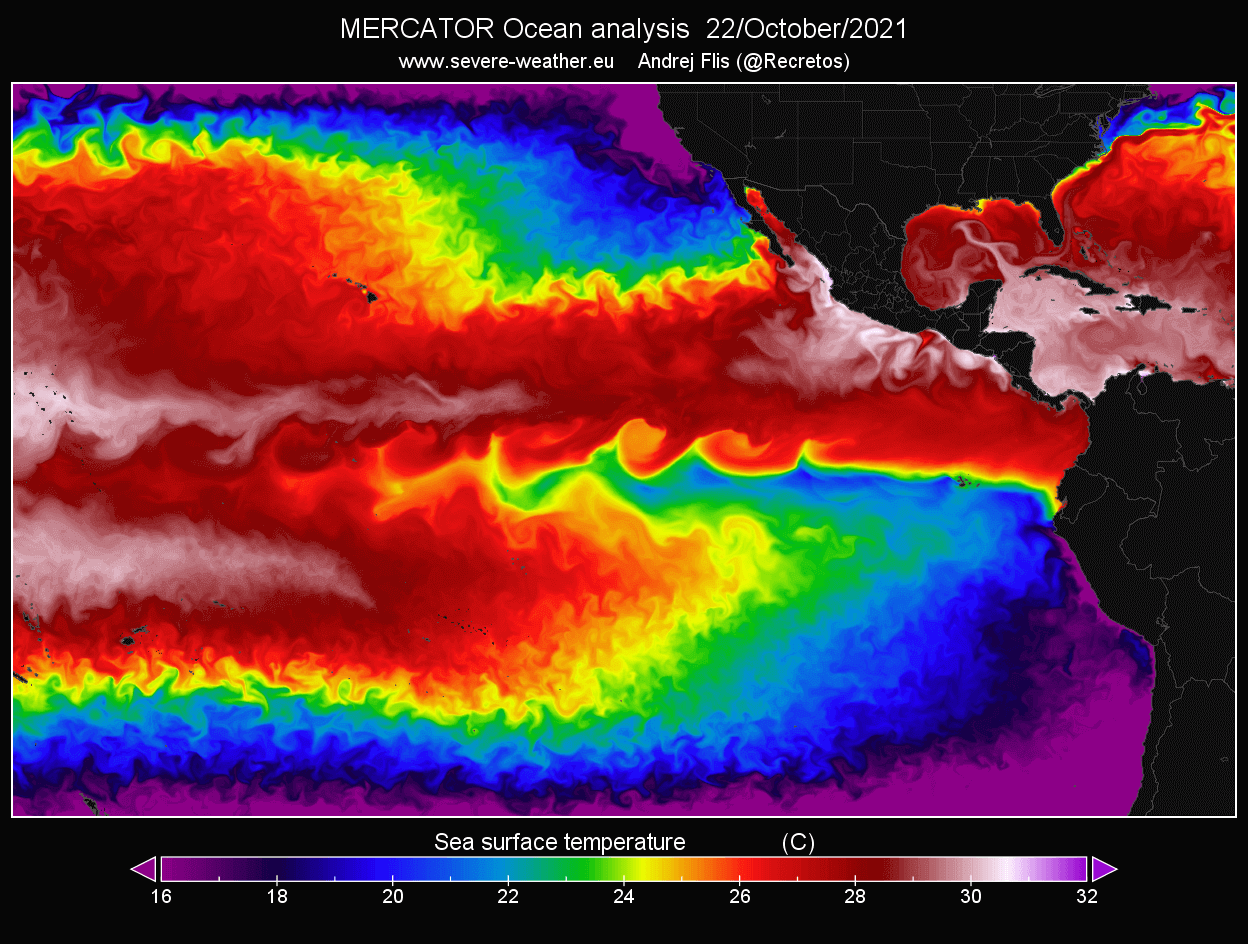
The next image below shows a cross-section by depth along the equator in the Pacific Ocean, from the Asian side on the left to South America on the right. The full vertical profile over the ENSO regions reveals the ocean temperature anomaly by depth. You can see that very strong cold anomaly are found between 50 and 150 meters below the surface.

Looking at the latest high-resolution analysis by depth under the ENSO regions, we see much colder temperatures. The large cold pool is now extending further west and going deeper, now reaching between 50 and 150 meters deep. This shows that the upwelling is strong, due to strong trade winds.
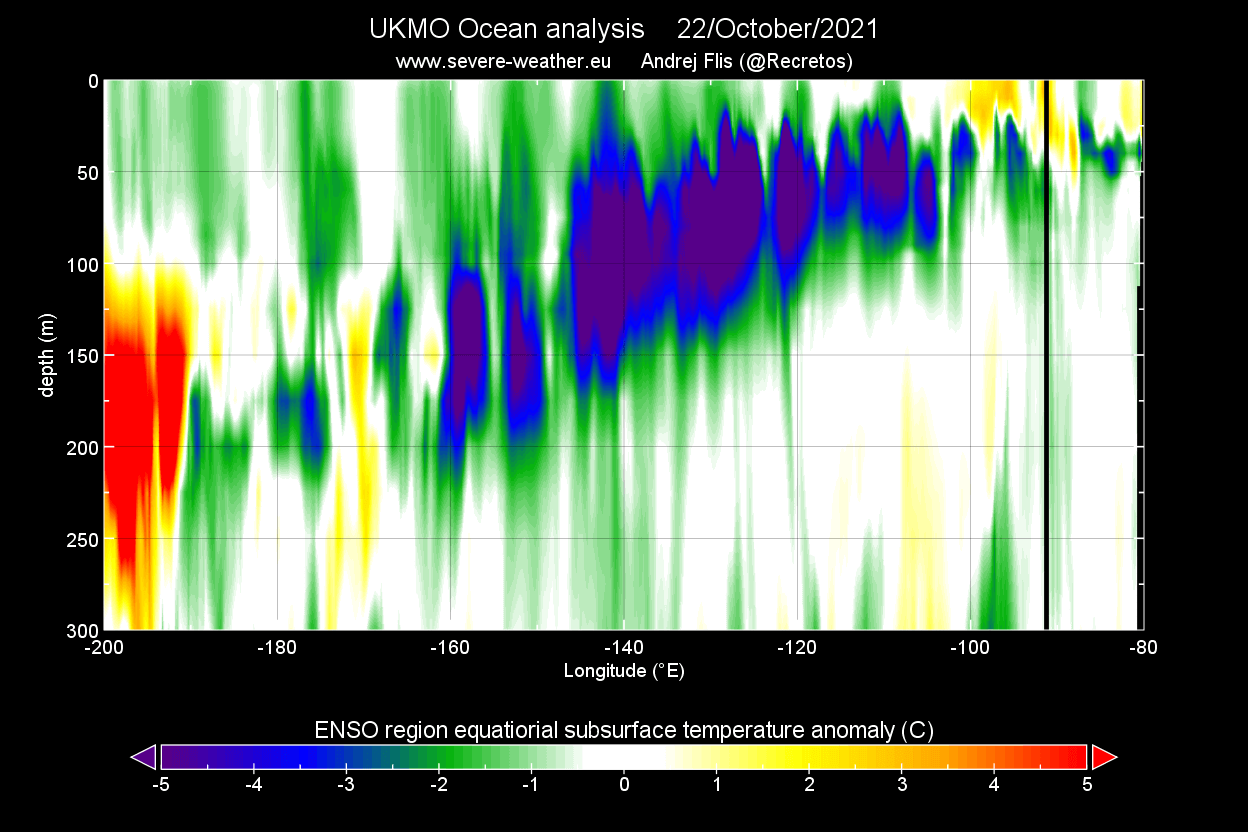
One way to look at the whole ENSO region temperature strength is by looking at the ocean heat content. This takes into consideration, not just the surface temperature, but also the water at depth. And below we can see the first La Nina of last year weakening in Spring. But lately, the upper-ocean heat content has been really colder than normal.
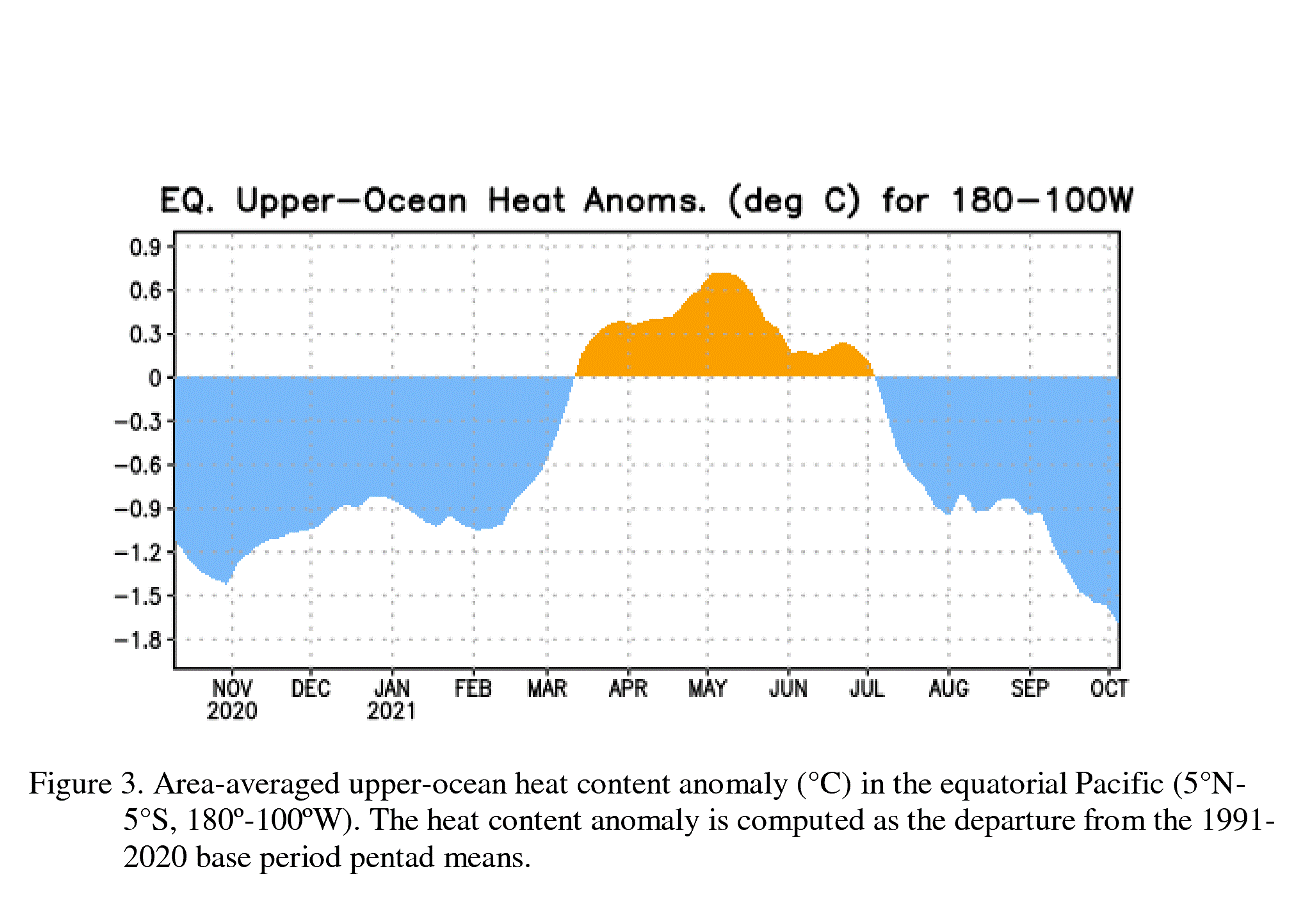
Based on all the available data, an official La Nina watch has been issued by the NOAA’s Climate Prediction Center:
“La Niña conditions have developed and are expected to continue with an 87% chance of La Niña in December 2021- February 2022. La Niña is anticipated to affect temperature and precipitation across the United States during the upcoming months.”
LA NINA FORECAST 2021/2022
Below we have the ocean temperature forecast for late Fall and early Winter from multiple global seasonal models, combined. It shows a developed La Nina across the equatorial Pacific Ocean. It is not as strong as last year, but has a strong presence in the ocean and also in the atmosphere, as we will see in the forecast part of the article below.
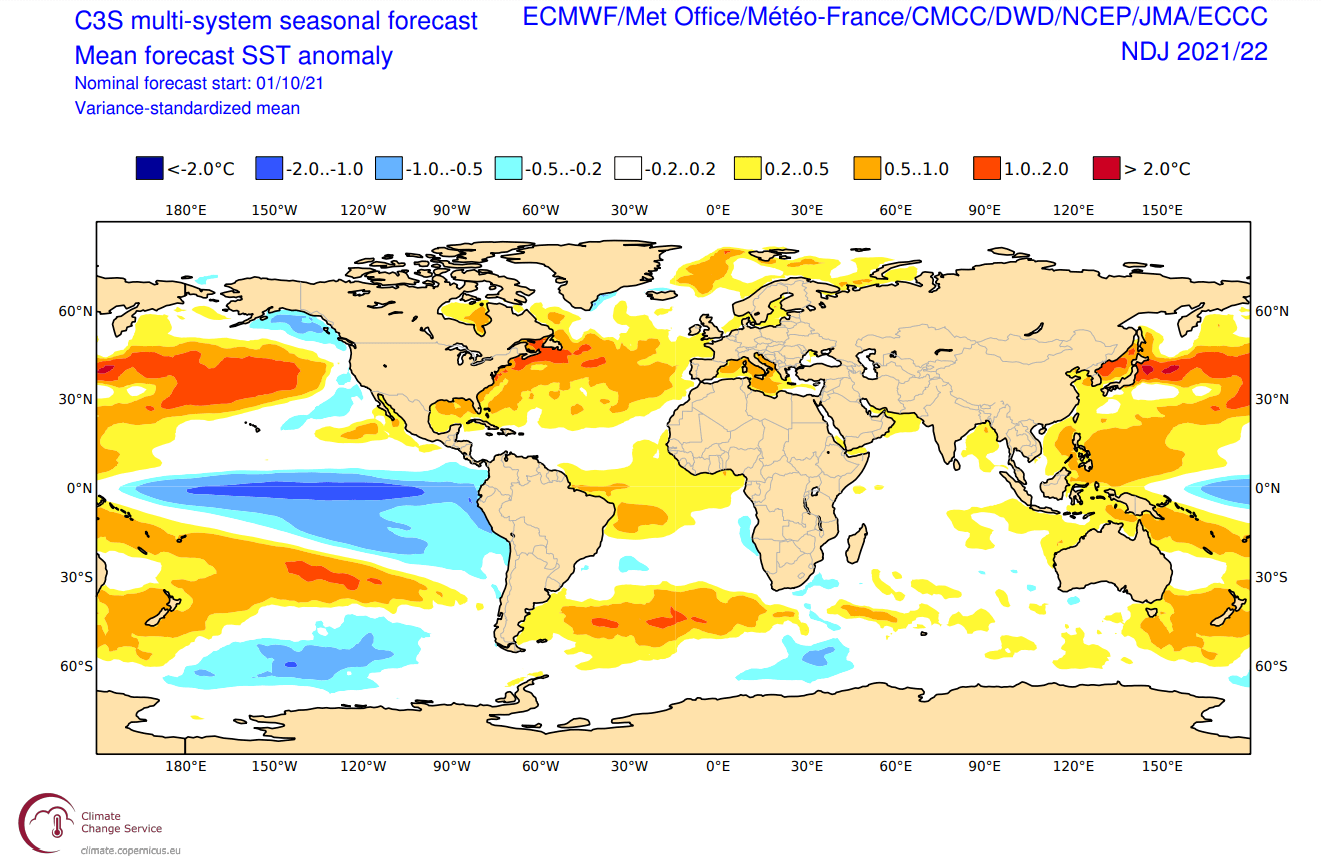
The ENSO region ensemble forecast below from ECMWF shows the La Nina starting to develop during late Summer, but cooling quickly, now going into Winter. We do see however a quick return to neutral conditions in early Spring. The rise, in the end, is quite rapid and if it continues could lead to a warm phase (El Nino).
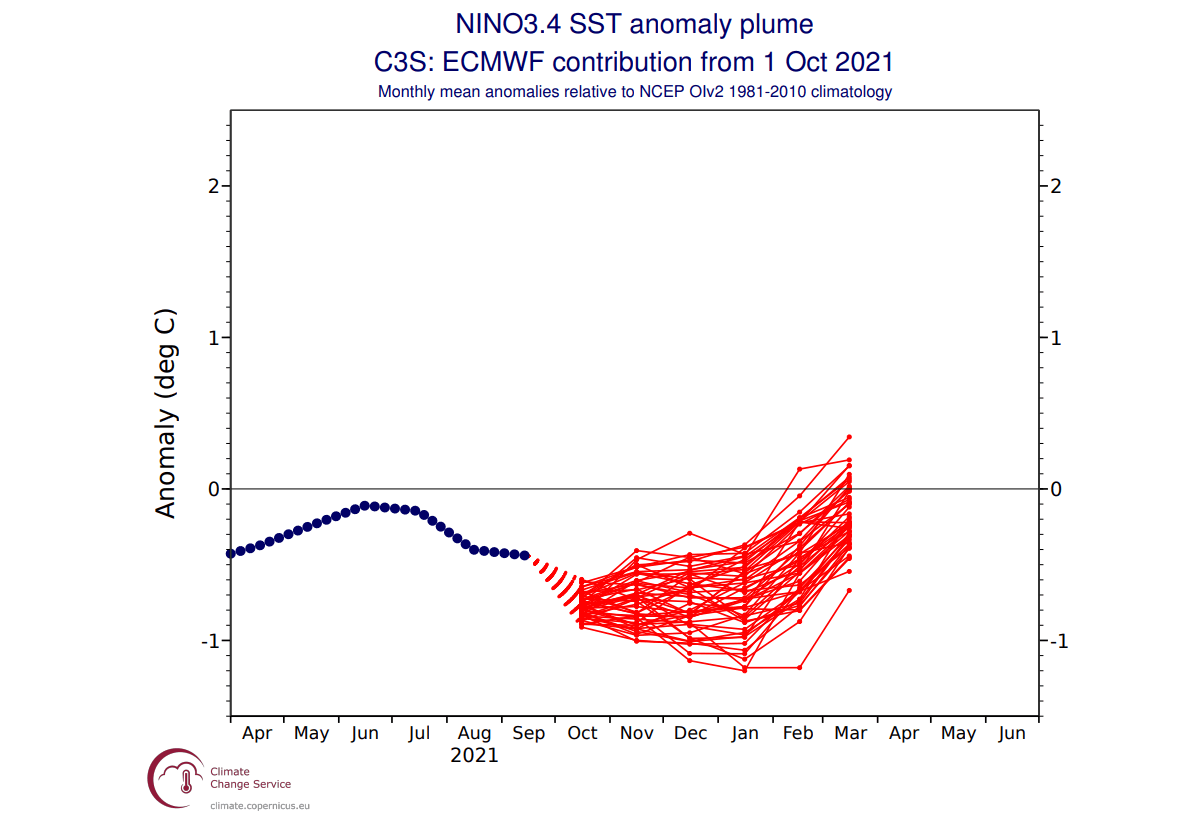
The ENSO forecast from the United States’ CFS model, shows a strong drop in temperature anomalies, but a mid-Spring return to neutral conditions. Going into Summer 2022, there is an increasing chance of going into a warm phase (El Nino).

The CPC/IRI official probabilistic ENSO forecast shows the current La Nina holding on over the winter season into early Spring 2022. What is interesting is the transition into summer, where we do see the chances of an El Nino increasing, just like on the CFS forecast above.

The ECMWF extended seasonal forecast from August actually shows the developing warm phase (El Nino) during Summer 2022. Mind you, that this forecast is from August. ECMWF does these extended seasonal forecasts every few months. The next extended cycle is coming in November, so our next ENSO update will include a fresh look at the 2022 ENSO forecast.
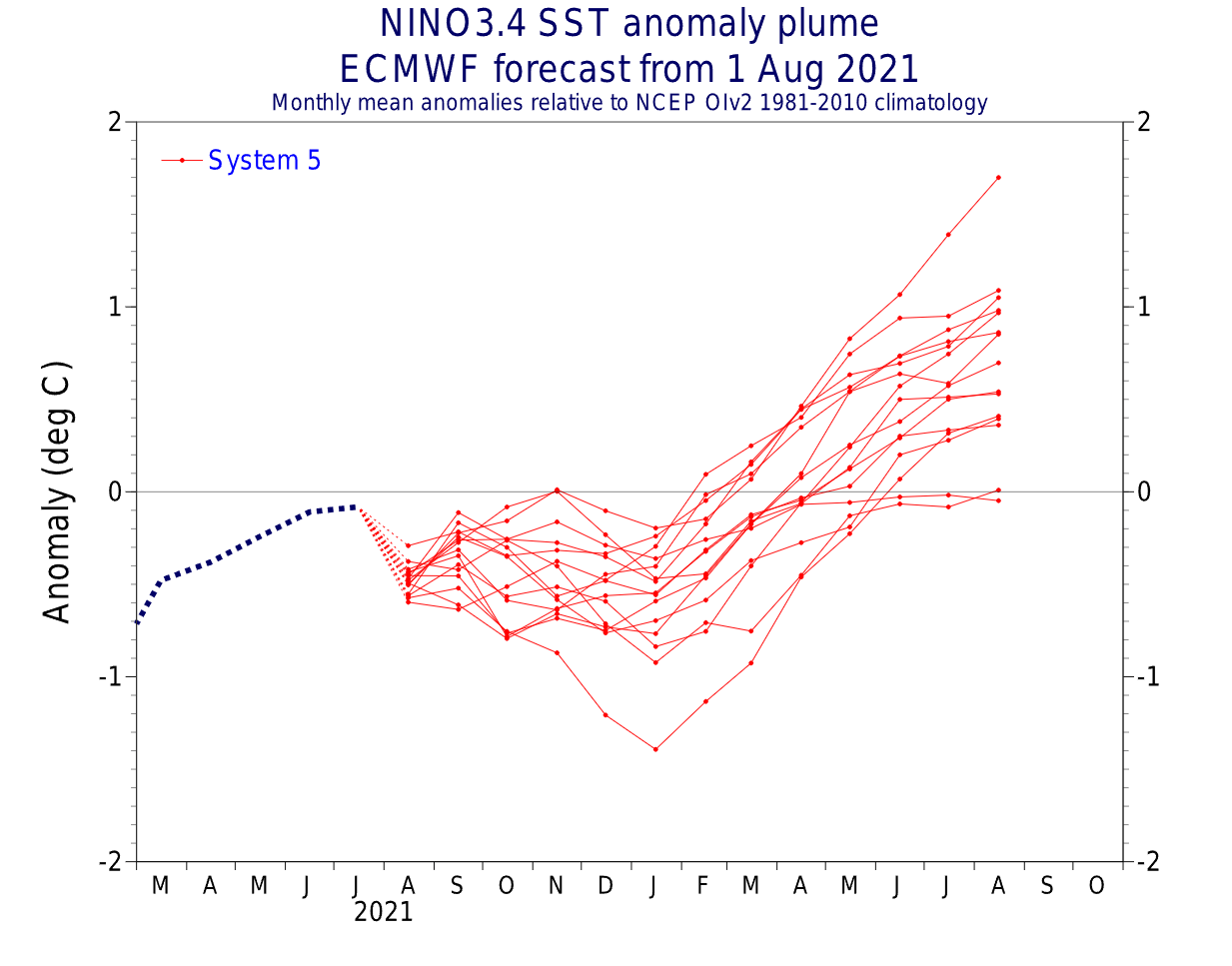
LA NINA OR ELNINO 2022
To fully understand the ENSO, we also have to look at its warm phase, named the El Nino. The forecasts are hinting at the emergence of an El Nino in 2022. This is why we will look at the main difference and weather influence of the El Nino versus a La Nina we are currently in.
On the image below we have a direct comparison between the El Nino and a La Nina as far as ocean temperature anomalies go. Both examples show realistic data, from the 10 strongest events for each phase.
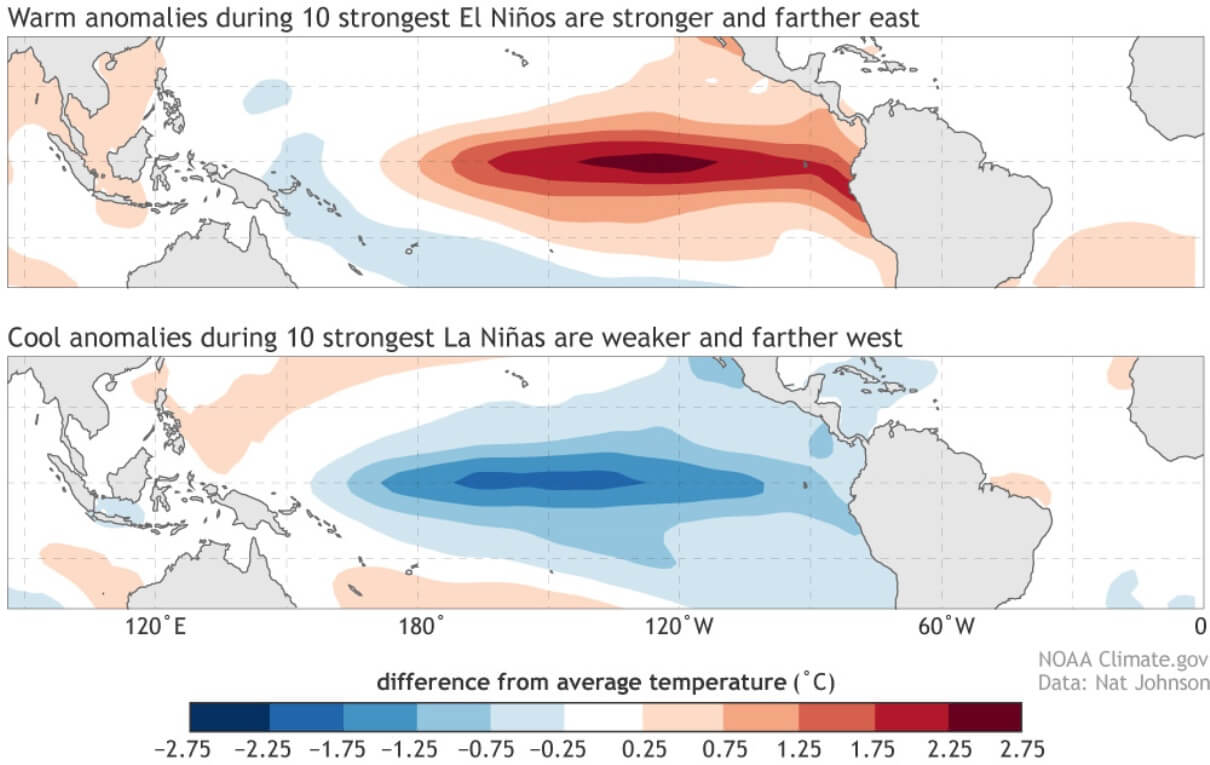
Below we have two specific images of ocean temperature anomalies, one is the strong La Nina in October 2020. The second is the strong El Nino event of the 2015/2016 winter season.
We can see a completely opposite situation and two different phases over the same area of the ocean. Cooler than normal ocean temperatures during a La Nina, and warmer than average temperatures during an El Nino. As we will see later, their influence on the weather is also almost a mirror image.


Not just the temperatures, the pressure is also one of the main differences. During an El Nino, the pressure over the tropical Pacific is lower, with more rainfall and storms. During a La Nina, the pressure over the equatorial Pacific is high, creating stable conditions. This obviously translates into the global pressure patterns, affecting the entire globe over time.
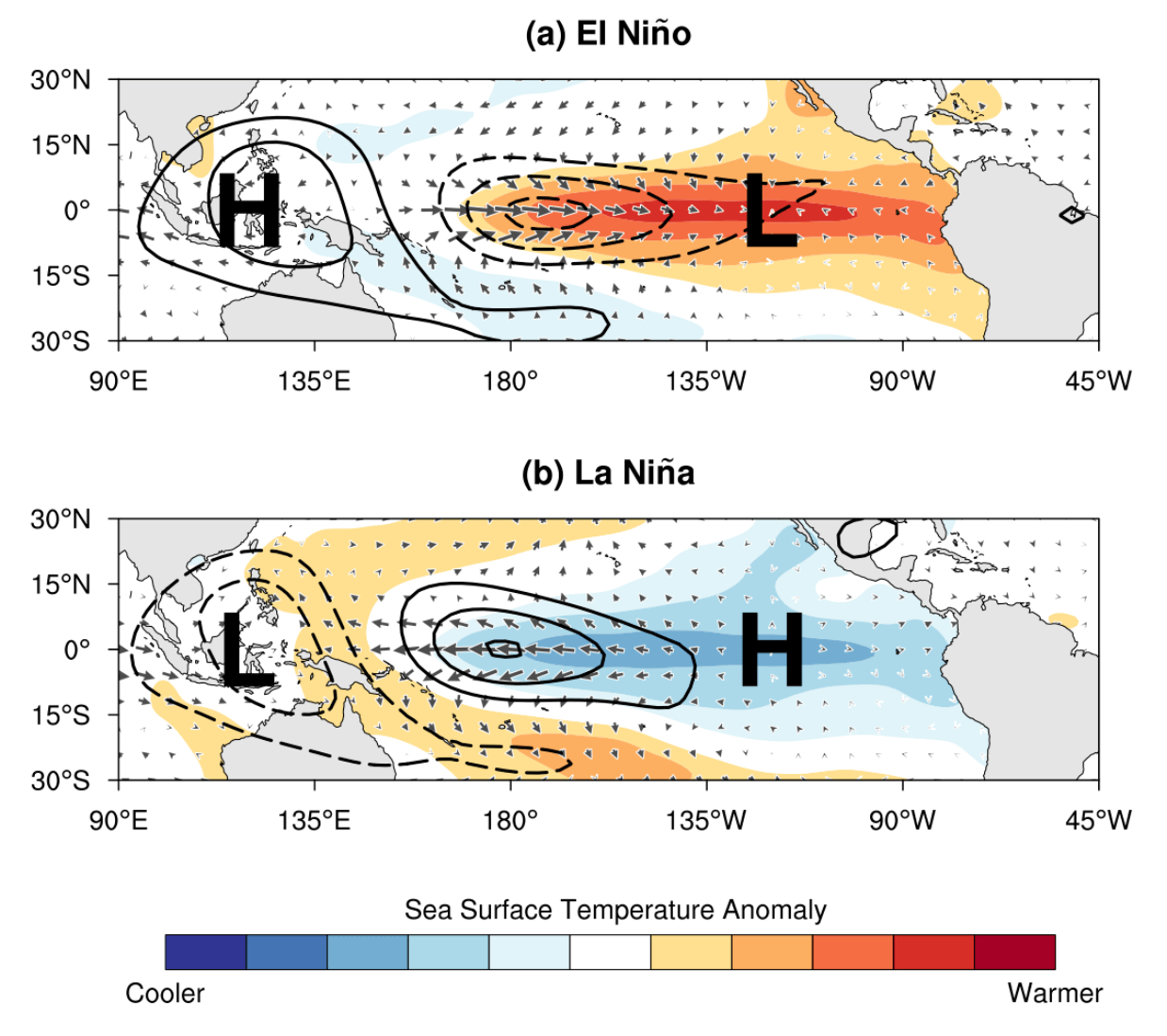
Looking at the actual temperature instead of the anomalies, we can also see a big difference in the temperature of the ocean surface. The first image shows the current sea surface temperatures of the new La Nina. The second image shows the temperatures during the strong 2015/2016 El Nino event.
Obvious again is the “cold tongue” of cooler ocean water during a La Nina, which creates these negative anomalies. The ocean temperature difference between the La Nina and El Nino can be quite large, up to 10 degrees Celsius in some places.
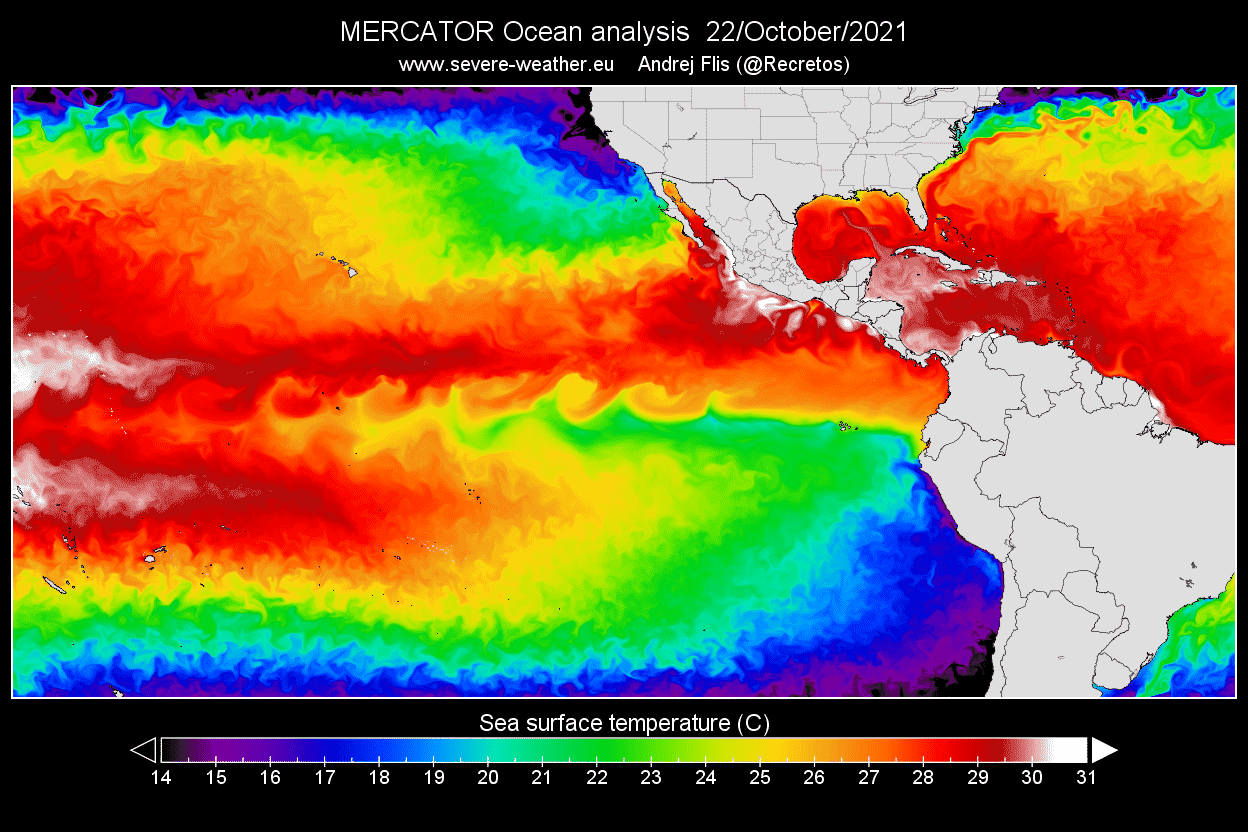
You can briefly see a very weak “cold tongue” also in the warm phase below, but it is very suppressed and much weaker than normal. This cold tongue is actually normal due to persistent easterly trade winds. But it is much stronger during a La Nina and much weaker during an El Nino, due to pressure changes affecting the wind direction and speed.

Strong trade winds are also important because they affect the food chain across the tropical Pacific regions and for both American continents. Strong trade winds mean that deeper and cooler water rises up from beneath the surface to replace the water that was pushed away.
This process is known as “upwelling.” Essentially this is a vertical transport process, as shown in the image below, which transports cooler waters and nutrients to the surface.
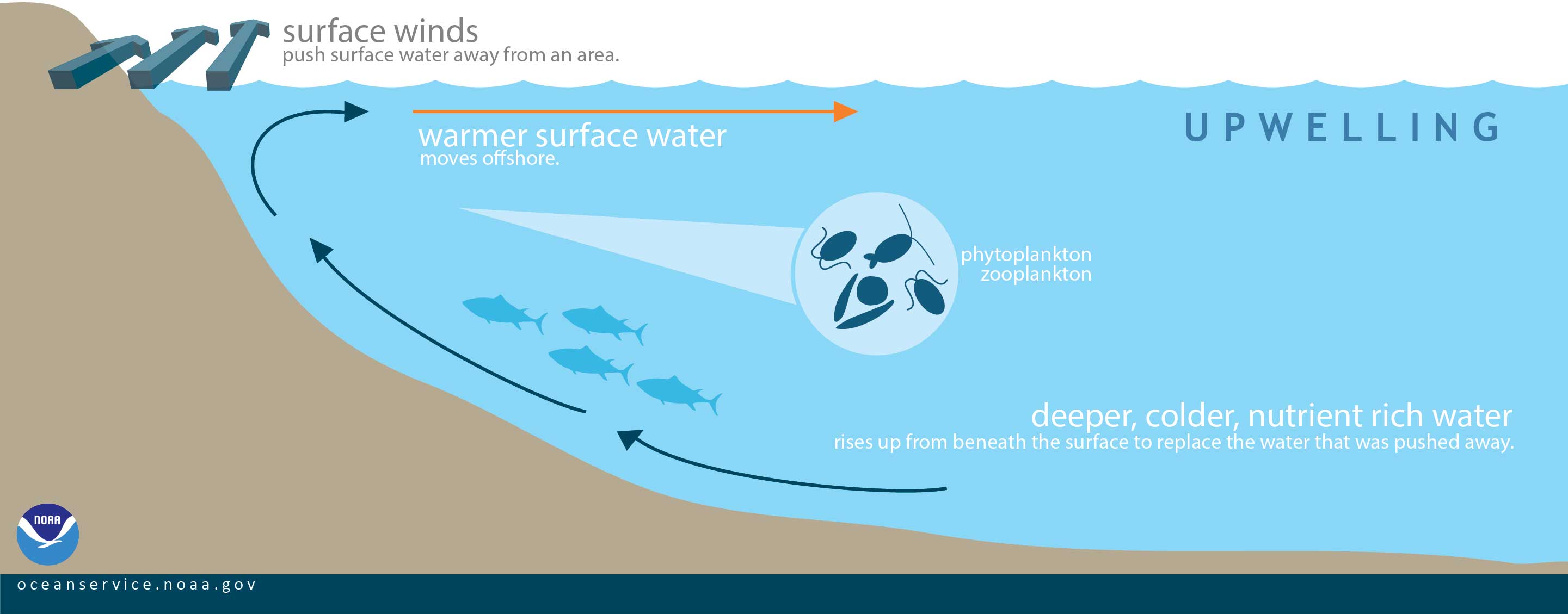
Water that rises to the surface as a result of upwelling is typically colder and is quite rich in nutrients. These nutrients can “fertilize” the surface waters. Basically, these surface waters often have high biological productivity. We can track that by looking at the amount of chlorophyll (phytoplankton) in the ocean.
The comparison below shows the Chlorophyll concentrations in the last La Nina (first image) and during the same period in the 2015 El Nino event (second image).
We can see that during La Nina, much more nutrients are available along the entire ENSO region, and also by the coastal areas of Middle and South America. This means more food is available for the fish, indicating a potentially good fishing season in the eastern equatorial Pacific.
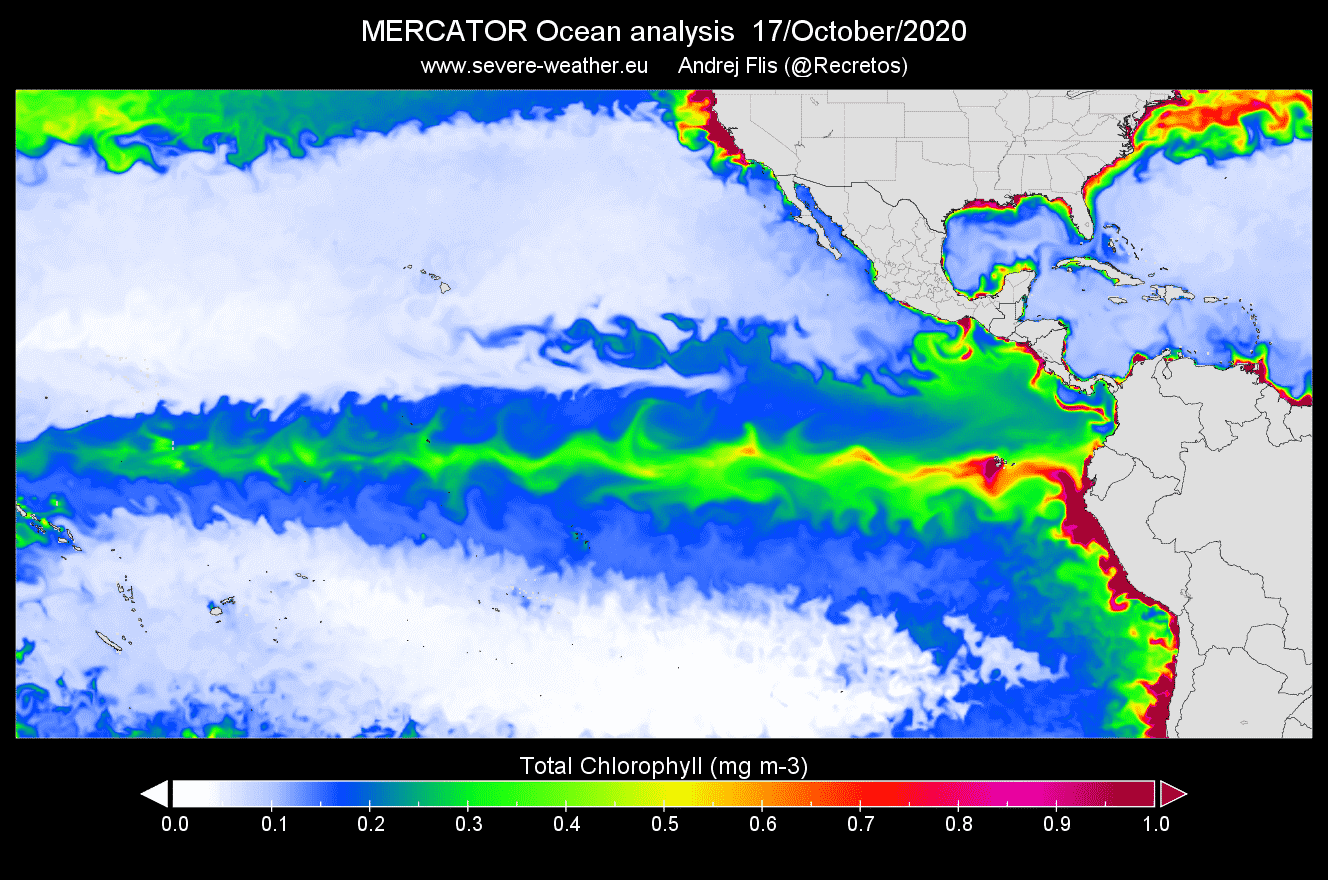

We can see this upwelling effect directly when looking at the temperature by depth during a La Nina and an El Nino event. The first image below shows the water temperature by depth during the 2015/2016 El Nino event. We can see much warmer waters in the upper-ocean layer, and cooler waters pushed deeper.

But below we have the latest subsurface analysis of the current La Nina event. You can nicely see how the 20°C threshold is much closer to the surface during a La Nina. This is due to the upwelling effect, as the trade winds cause the deeper colder water to rise towards the surface.
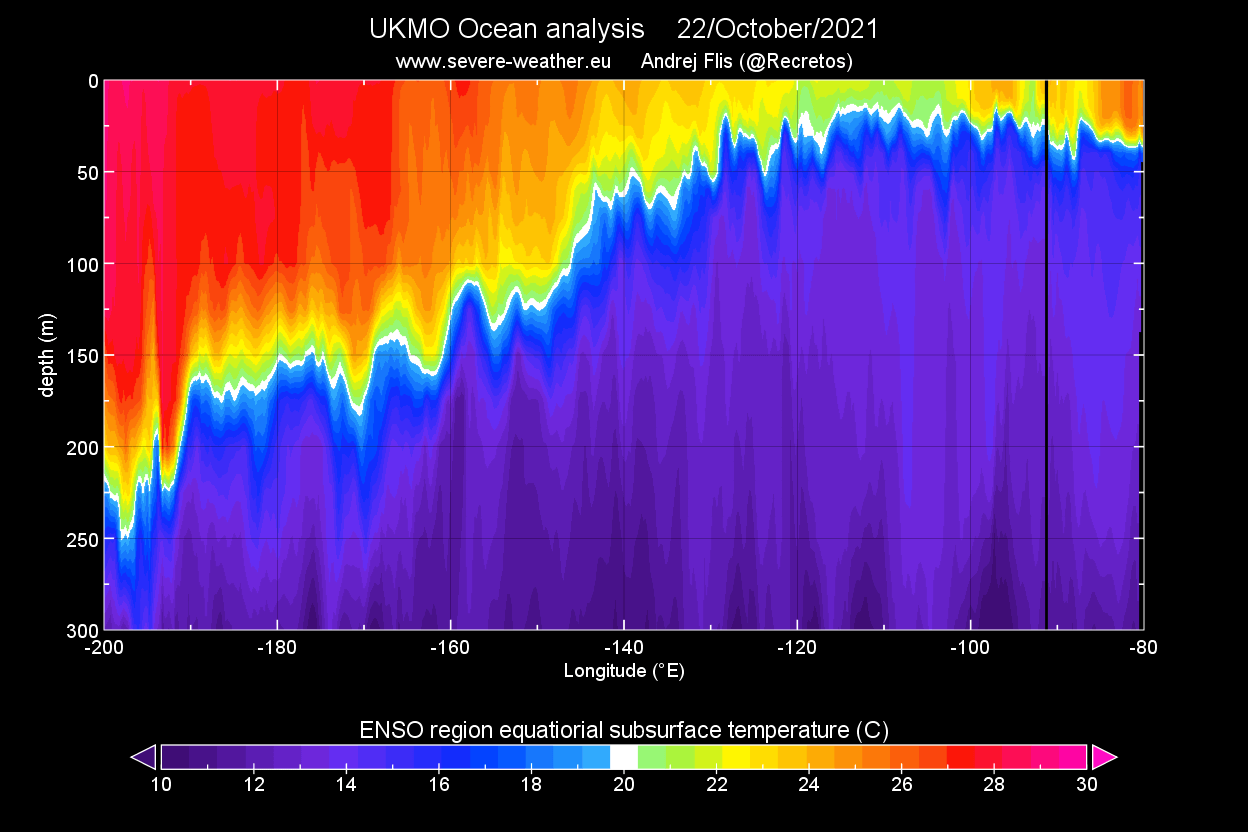
The layer between the warmer and colder waters is called the “Thermocline”. This is a thin layer where the ocean temperatures drop significantly, separating the upper warm and deeper cold layers. In an El Nino, the thermocline layer is pushed deeper. That is due to the warmer waters from the west entering the region, warming the upper-ocean layers.

LA NINA, EL NINO AND WINTER WEATHER
At this point, we have to add, that an ENSO phase is not just a pure “influencer” for our weather. It can also be viewed/interpreted as somewhat of a response to the overall global state of the atmosphere. Almost like a “warning light” on the dashboard of a car. But generally, ENSO does indicate an important influence on the Jet stream in the Pacific Ocean, and consequently also around the world.
The jet stream is a large and powerful stream of air (wind) at around 8-11km (5-7mi) altitude. It flows west-to-east around the entire hemisphere, affecting the pressure systems, their strength, directly shaping our weather at the surface.
Comparing the two phases of the ENSO on the next image below, we can see that they typically produce an entirely different winter weather pattern across North America, as they have a major influence on the position of the jet stream.
La Nina features a stronger and extended polar jet stream from Alaska and western Canada into the United States. But the El Nino features a stronger Pacific jet stream and an amplified storm track over the southern United States.
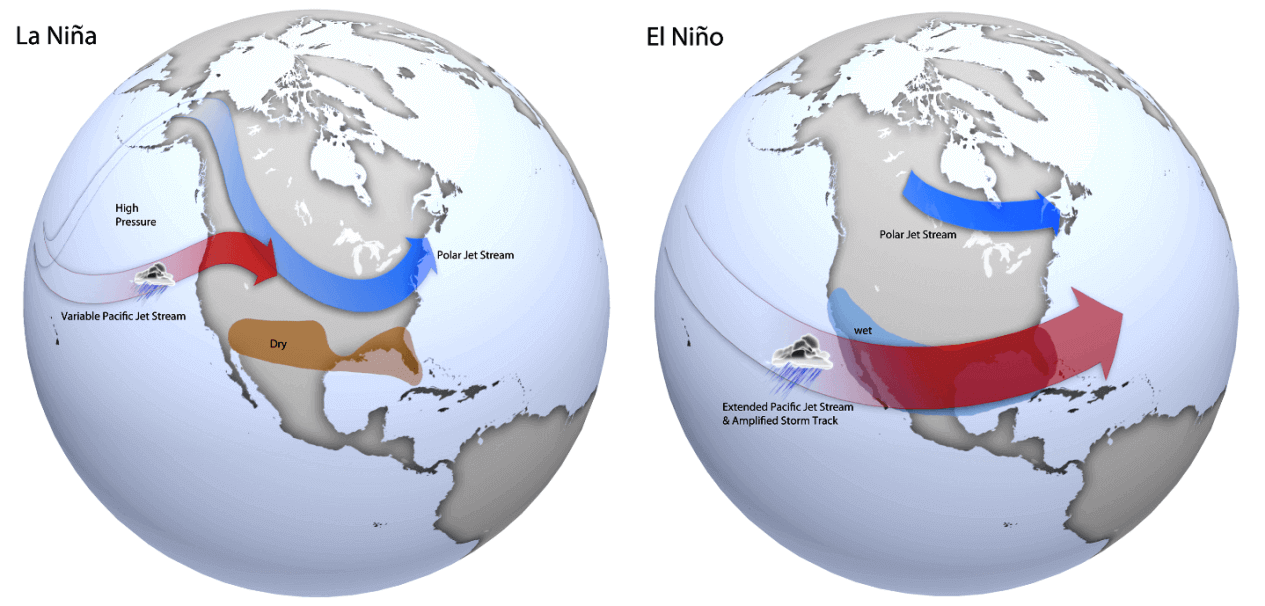
Looking closer at La Nina below, we can see that its main feature is a strong and persistent high-pressure system in the North Pacific. It usually bends the jet stream from the northwest down to the southeast, creating a dipole pattern over the United States.
Alaska, western Canada, and the northern United States typically experience colder than normal winter, with more precipitation. Southwest and the southern United States usually experience warmer and a bit drier conditions during La Nina winters.
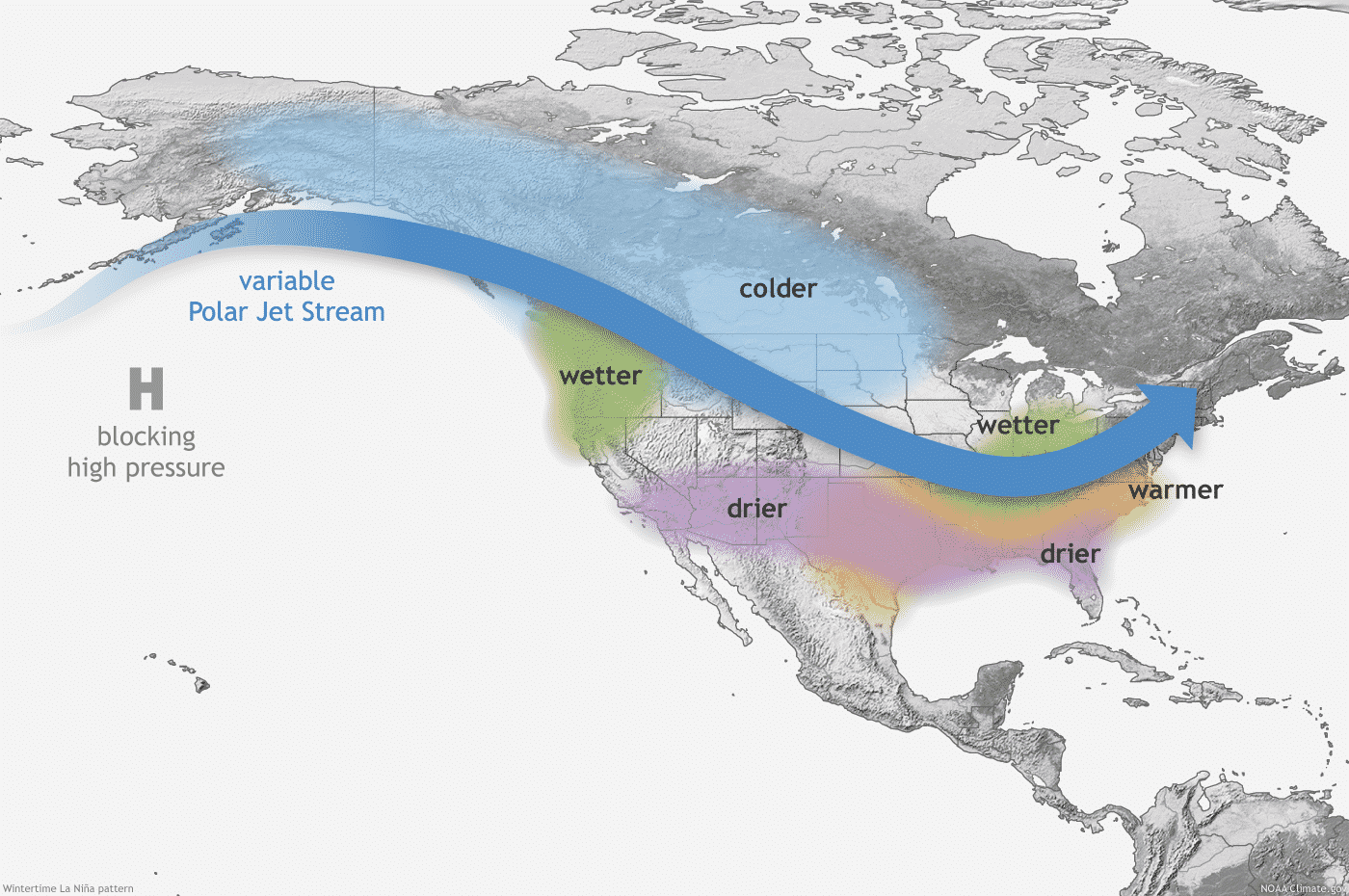
The shifted jet stream also means a different snowfall potential over the continent. The colder air is more easily accessible to the northern United States, which also shows to have an increased snowfall potential during the La Nina winters. Especially areas like Alaska, western Canada, and the northern United States benefit from the northerly jet stream to produce more snowfall. The graphic below is by NOAA-Climate.
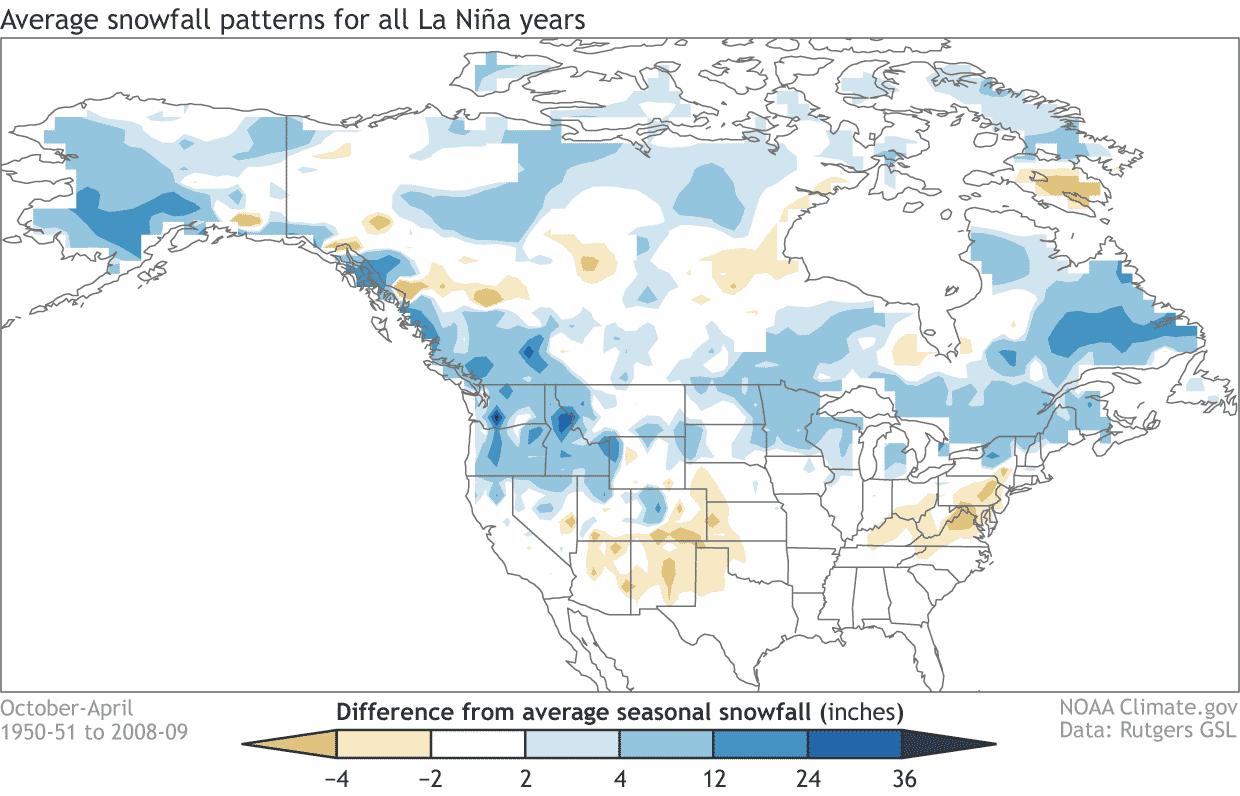
But during an El Nino winter season, we have a strong and persistent low-pressure area in the North Pacific. That pushes the polar jet stream further to the north, bringing warmer southerly flow to the northern United States and western Canada. The southerly Pacific jet stream is amplified, bringing storms with lots of precipitation to the southern United States.
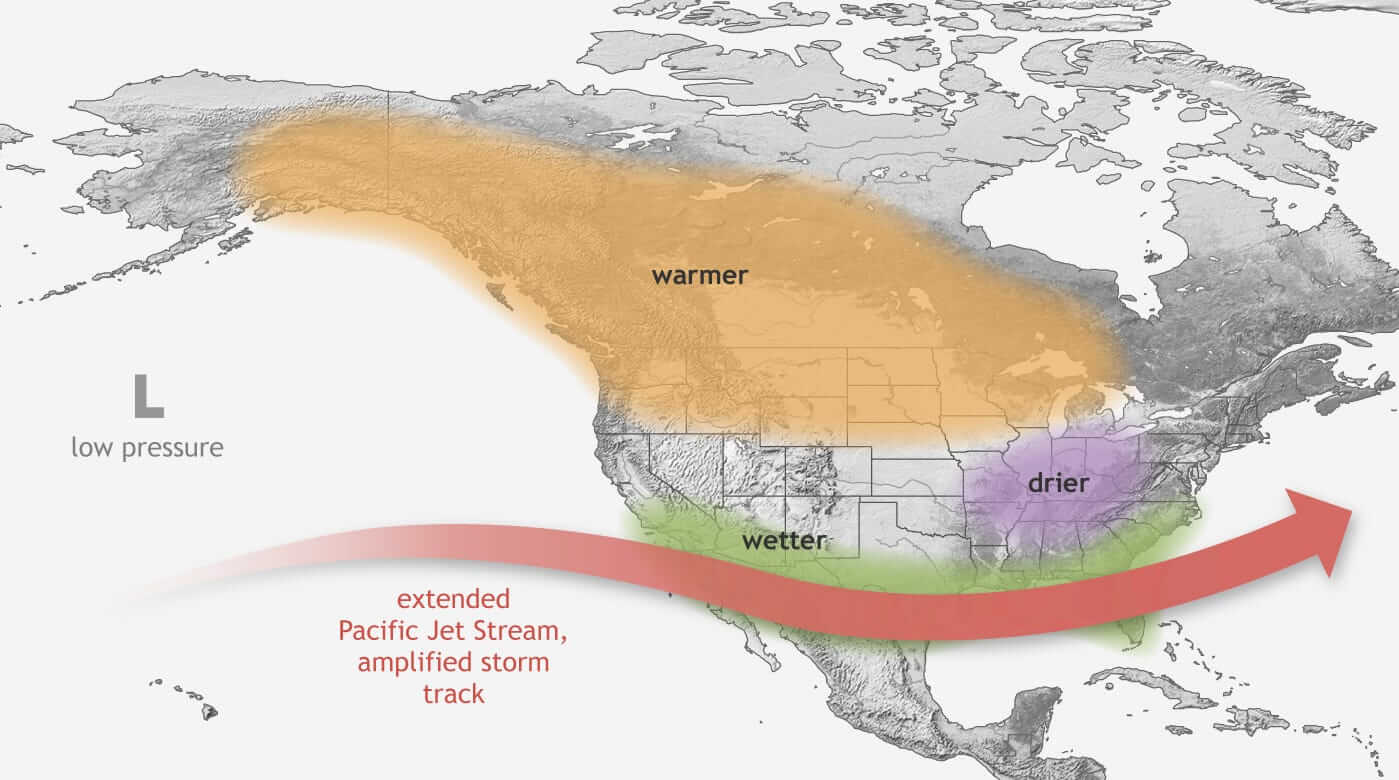
Looking at snowfall in the El Nino winters, we can see a much different picture than during the La Nina. There is less snowfall in the northern United States during the El Nino winter season. The conditions are mostly warmer and drier than normal there. But there is more snowfall in the west-central United States and in the parts of the eastern United States.

After passing Canada and the United States, the jet streams move out into the Atlantic. There are different paths they can take. A lot depends on the overall circulation pattern and the existing pressure systems in the Atlantic. This is where ENSO generally perhaps loses its direct influence for Europe, as regional systems in the Atlantic take over.
But it usually still has an important influence, as it changes the position of the entering jet stream from the west. The incoming jet stream can merge with the systems in the Atlantic, helping to create a whole new weather pattern for Europe. The problem is that the final outcome is far more unpredictable in this zone than over North America, which feels a much more direct and predictable influence.
WINTER SEASON 2021/2022 ENSO INFLUENCE
We have seen that the main feature of La Nina winters is a strong high-pressure system in the North Pacific. On the image below you can see the average winter pressure pattern during second-year La Nina events in the past decades. The main notion is the strong high-pressure system in the North Pacific, sending the polar jet stream over the northern United States.

In the pressure pattern forecast from ECMWF below, we can see this strong high-pressure system in the North Pacific, typical for a La Nina. A low-pressure system is developed over western Canada and the jet stream is bending in between the two pressure systems, just like we have seen in the previous segment.
We also see the North Atlantic in a somewhat positive/neutral NAO mode, which means an amplified jet stream over the British Isles and northern Europe. But this is not a typical positive NAO setup and shows a lot of variability over the winter season. It allows for winter situations over Europe. Most likely if the high-pressure system in the central Atlantic can crawl further up north, blocking the jet stream and creating a more northerly flow into Europe.

Over Noth America, the ECMWF forecast shows colder than normal temperatures over much of Alaska, Canada, and the northwestern United States. Warmer than normal temperatures are forecast for the southern regions. This is not the final forecast, as it is just the October update. It is expected to see more neutral/colder temperatures covering a larger area of the northern United States on the final forecasts as we get closer to the winter season.
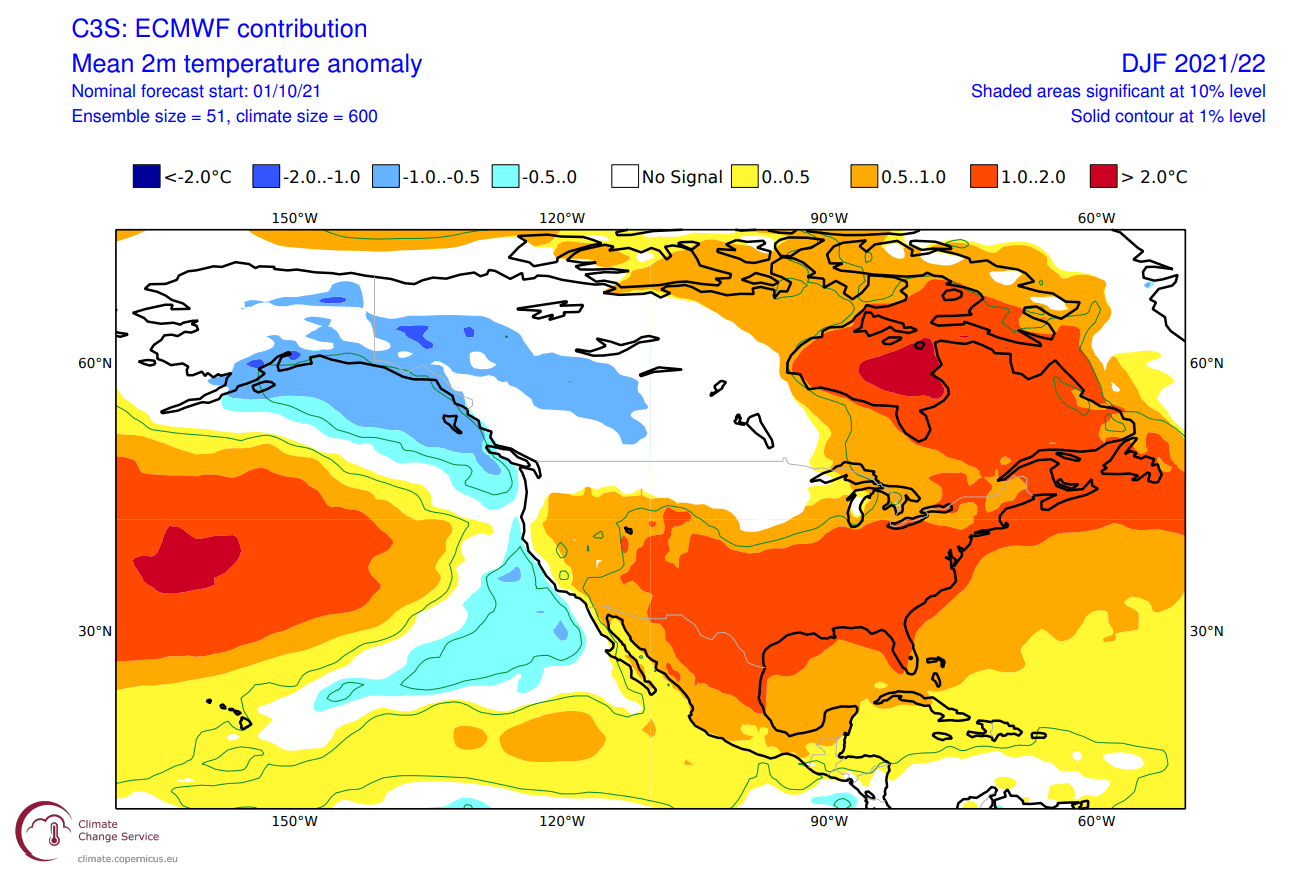
Looking at the ECMWF snowfall forecast, we see a very interesting pattern. The ECMWF suggests more snowfall than usual in most of the western United States. The increased snowfall potential continues over the Midwest and into southeastern Canada. Most of the central and eastern United States regions are forecast to have slightly less snowfall. This is somewhat of an expected scenario for a La Nina winter season.

Below we have the official temperature forecast for the United States by NOAA. It shows the temperature probability, with colder to equal chances in the northwestern United States and the Midwest. Most of the southern half of the country has a higher probability of warmer than normal weather this winter season.
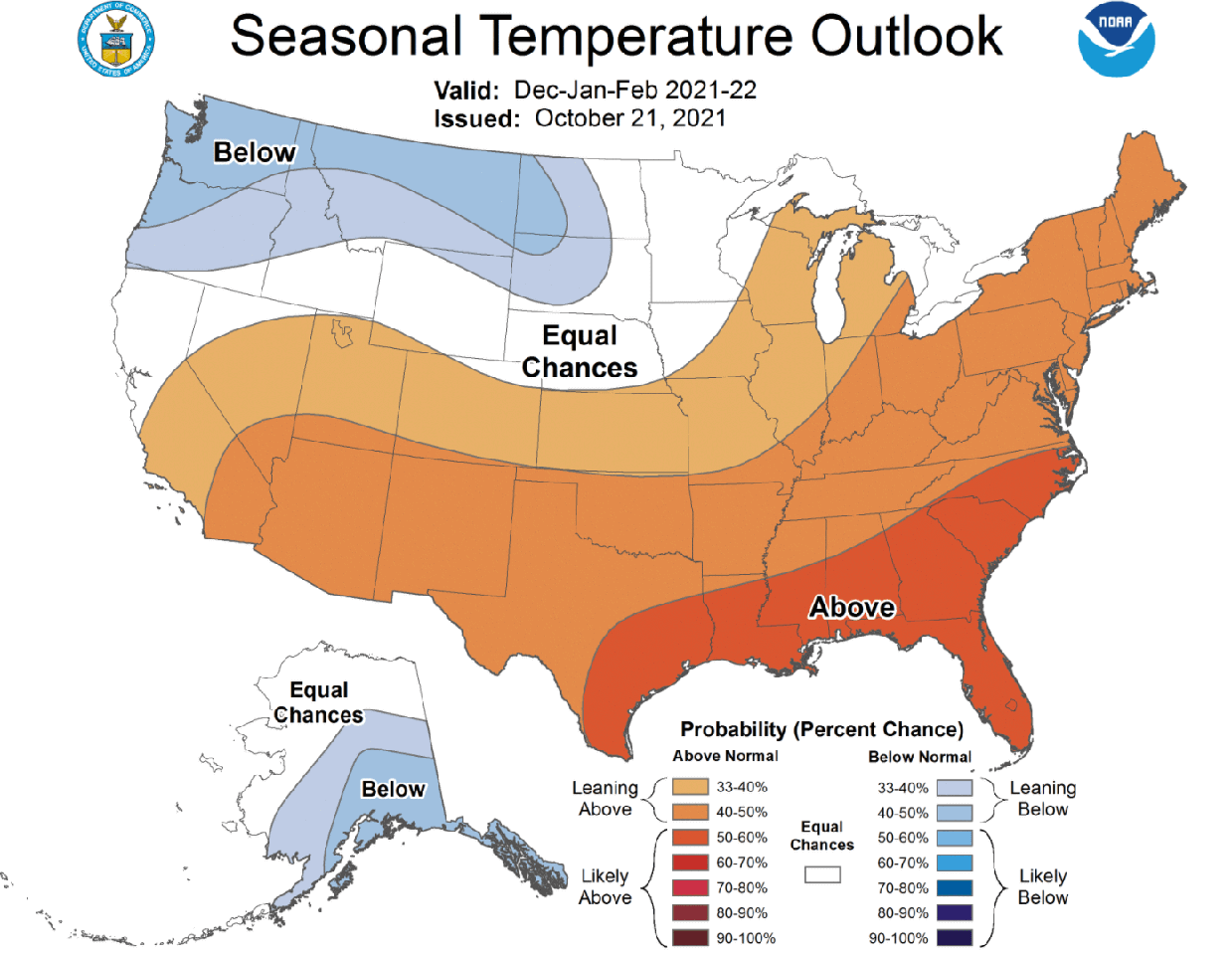
The official precipitation forecast is quite similar to expected La Nina conditions. We see an equal-to-higher probability for more precipitation (and snowfall) in the northwestern and the northeastern United States. The Southern United States is mostly drier than normal, especially in the southwest.
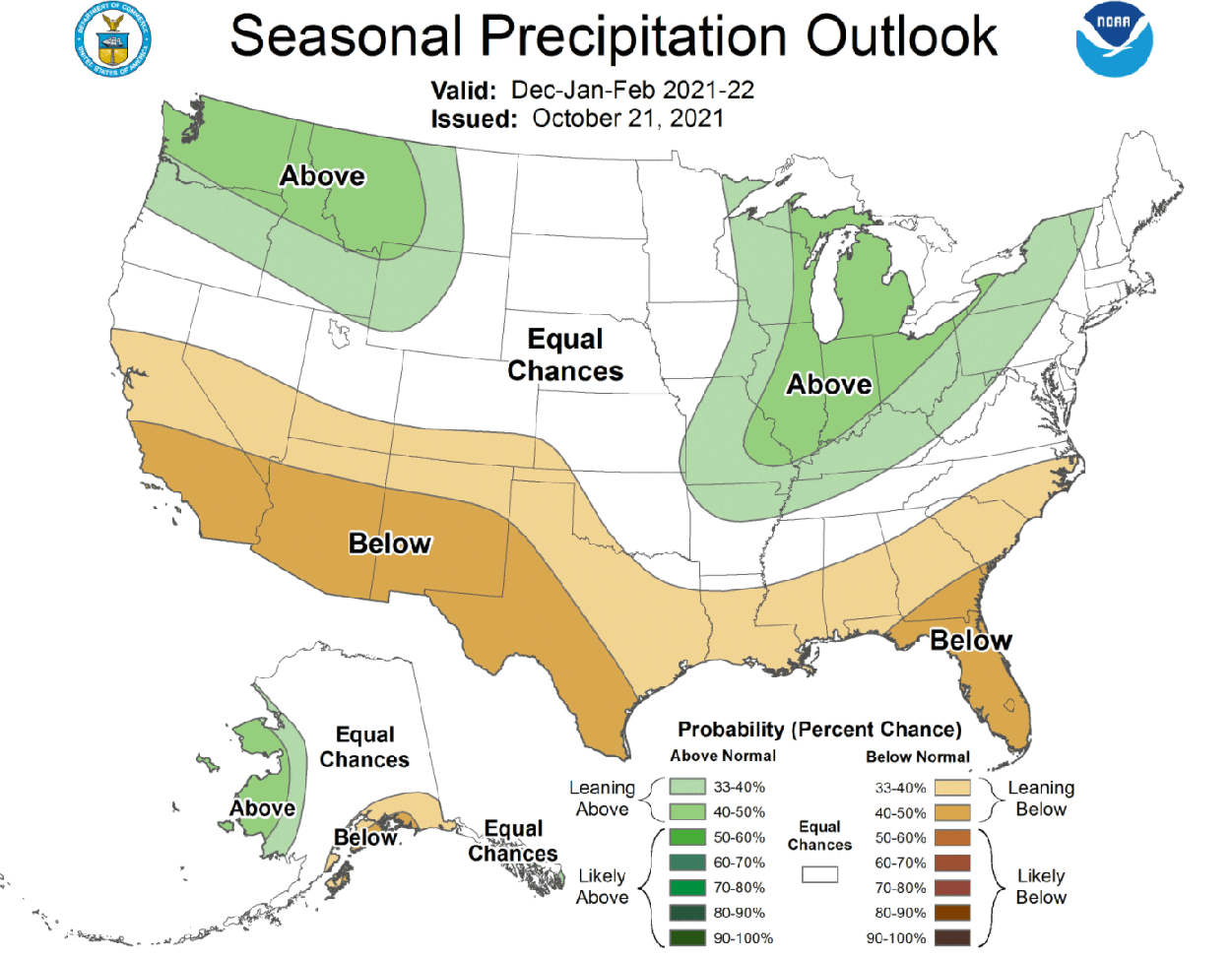
All in all, this shows a clear sign that the strengthening of La Nina is solidifying its influence on the winter season in the United States and the entire North American continent. The confidence is growing for a very different winter season between the northern and the southern United States.
We will keep you updated on the developing La Nina and its Winter 2021/2022 influence, so make sure to bookmark our page. Also, if you have seen this article in the Google App (Discover) feed, click the like (♥) button to see more of our forecasts and our latest articles on weather and nature in general.
SEE ALSO: